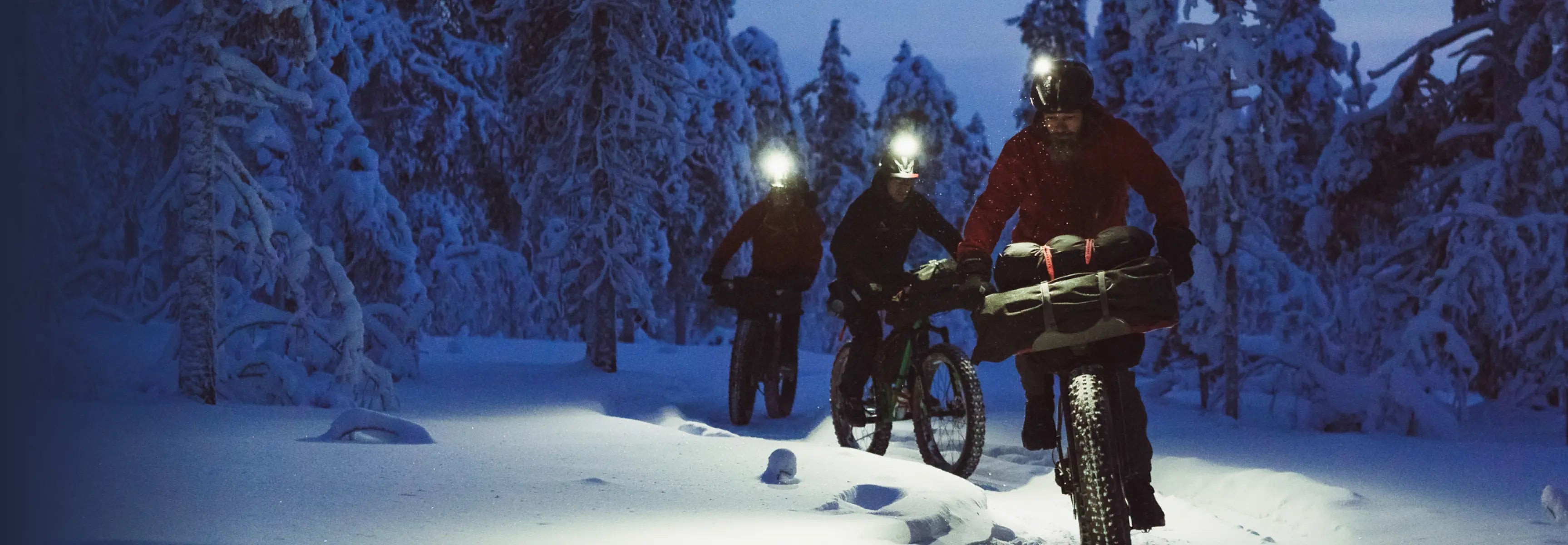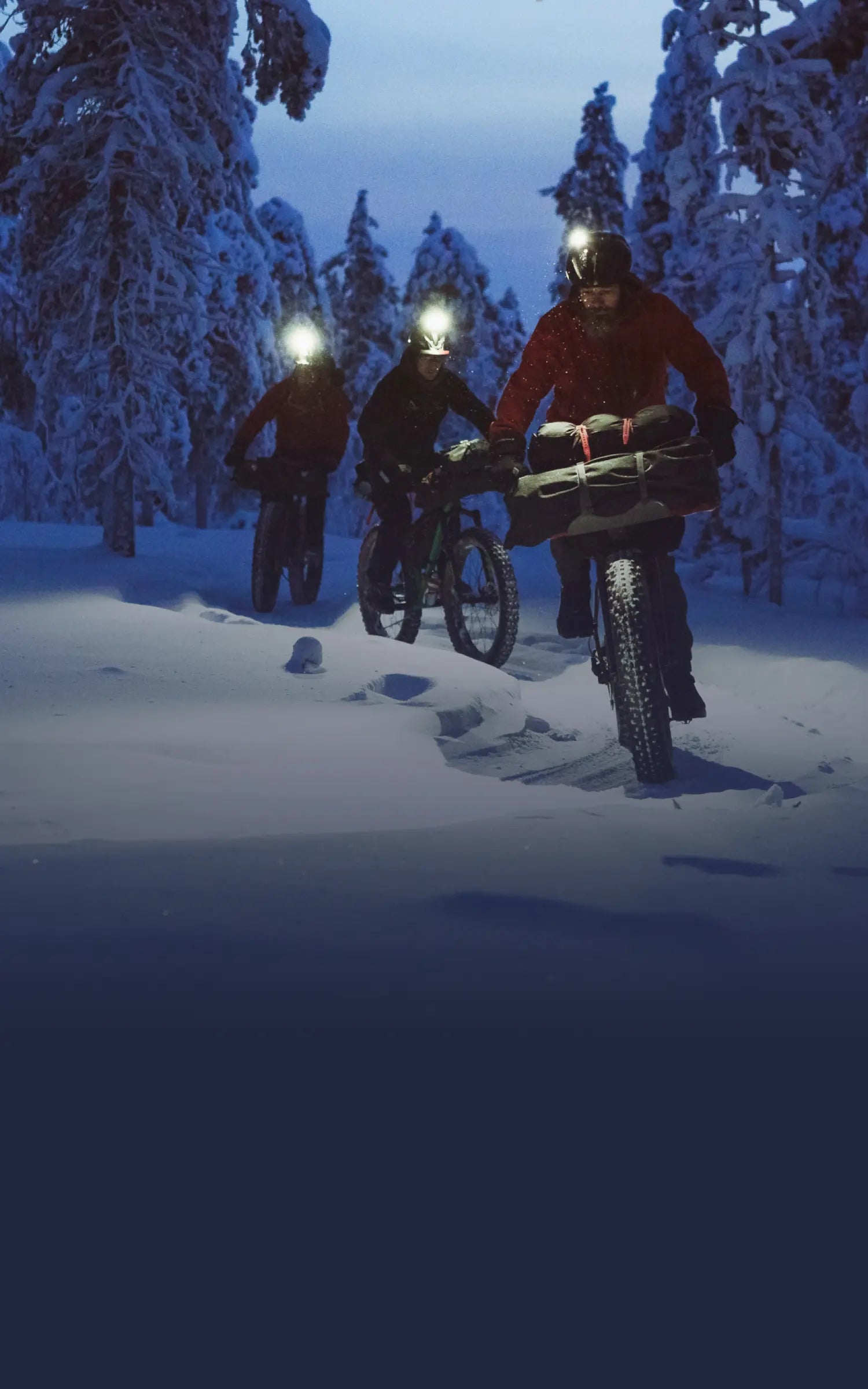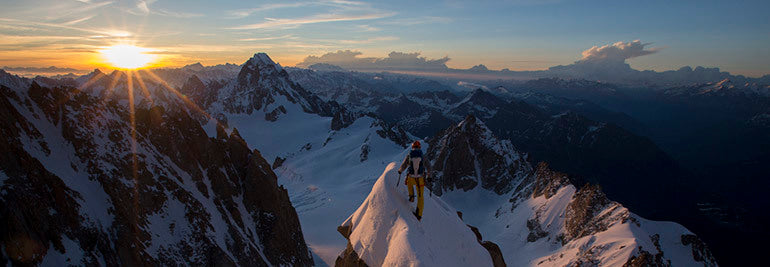

Suunto Blog

We miss you, Ueli
Ueli, may your spirit forever guard others who live their dreams in the mountains. We miss you – and your broad smile.

How to track activity and recovery with Suunto 3
TRACK YOUR ACTIVITY LEVELS WITH STEPS AND CALORIES
From the watch face display, press the lower right button until you see your total steps for the day. Pressing the middle button once will reveal your steps over the last seven days.
Your Suunto 3 keeps track of your overall level of activity throughout the day. It counts steps using an accelerometer. The total step count accumulates 24/7, also while recording exercises and other activities. However, with some specific sports, such as swimming and cycling, steps are not counted.
To switch from daily steps to estimated daily calories, press the upper left button. The total calories you burn per day is based on two factors: your Basal Metabolic Rate (BMR) and your physical activity.
Your BMR is the amount of calories your body burns while at rest. These are the calories your body needs to stay warm and perform basic functions like blink your eyes or beat your heart. This number is based on your personal profile, including factors such as age and gender.
When you set a calorie goal (see below), you define how many calories you want to burn in addition to your BMR. These are your so-called active calories.
The large number in the center of the display is the estimated amount of active calories you have burned so far. Below this you see the total calories burned. The total includes both active calories and your BMR.
You can view a weekly summary in your watch or long-term trends in the diary section of your Suunto app.
SET YOUR ACTIVITY GOALS
The ring in both the steps and calories displays indicates how close you are to your daily activity goals. You can adjust the goals in your watch settings (Settings >> Activity) or by keeping the middle button pressed in the activity display to open the activity goal settings.
When setting your target for steps, you define the total number of steps for the day. When you set your calorie goal, you define how many calories you want to burn in addition to your BMR.
Both activity counters automatically reset at midnight every day.
FOLLOW YOUR DAILY HEART RATE TREND
Enable Daily HR under the Activity settings (Settings >> Activity)
The daily HR display provides a 12-hour view of your heart rate. This is a helpful source of information about, for example, your recovery after a hard training session.
The display shows your heart rate over 12 hours as a graph. The graph is plotted using your average heart rate based on 24-minute time slots. In addition, you get your lowest heart rate during the 12-hour period.
Your minimum heart rate from the last 12 hours is a good indicator of your recovery state. If it is higher than normal, you probably are not fully recovered yet from your last exercise.
Read more about Daily HR
TRACK YOUR SLEEP DURATION AND QUALITY
Suunto 3 tracks your sleep, too.
A good night's sleep is important for a healthy mind and body. You can use your Suunto 3 to track your sleep and follow how much sleep you are getting and how well you are sleeping.
A lack of sleep or sleep that does not provide sufficient recovery exposes you to illnesses and weakens your physical fitness. Your body can withstand individual nights of sleep that do not provide sufficient recovery, but if the situation drags on, the risk of overload increases.
Turn sleep tracking on and set your bedtime at settings (Settings >> Sleep >> Sleep tracking). The last step defines your bedtime. Your watch uses that period to determine when you are sleeping (during your bedtime) and reporting all sleep as one session. It is better to set the bedtime a little longer than you actually will be sleeping to make sure you get all your sleep tracked. If you get up for a drink of water during the night, for example, your watch still counts any sleep after that as the same session. At the settings you can also set a target duration for your sleep.
Duration is only one aspect of sleep. The amount of sleep we need changes from day to day, from person to person, and even as we get older. We have all woken up after a full 8 hours of sleep feeling tired, particularly during stressful times. At other times, we wake up fresh with a good deal less sleep than expected.
Not all sleep is equal. Quality matters. Personal, behavioral, dietary, and environmental factors can all impact the restorative quality of your sleep. That’s why you can also track your sleep quality with your Suunto 3 Fitness.
Your sleep quality is assessed by following your heart rate variability during sleep. The variability is an indication of how well your sleep is helping you rest and recover. Sleep quality is shown on a scale from 0 to 100 in the sleep summary, with 100 being the best quality.
To measure sleep quality you will need to have Daily HR on (see above). Learn more here.
When you wake up in the morning you will see a summary of your sleep. You can follow your overall sleep trend by scrolling down to the sleep insight from the watch face or in diary of your Suunto app.
LEARN TO MANAGE STRESS AND RECOVERY THROUGHOUT YOUR DAY
Your Suunto 3 also measures your stress and recovery throughout the day to help you ensure you have enough in the tank to make it through the day.
Stress and physical activity deplete your resources, while rest and recovery restore them. Good sleep is an essential part of ensuring your body has the resources it needs.
The gauge around this display indicates your overall resource level. If it is green, it means you are recovering. If it is gray, you are not recovering, but can still be adding to your overall resources. The status and time indicator tell you your current state (active, inactive, recovering or stressed) and for how long you have been in that state.
Press the middle button to see a bar chart of your resources over the last 16 hours.
When your resource levels are high, you will likely feel fresh and energetic. Going for a run when your resources are high means you'll probably have a great run, because your body has the energy it needs to adapt and improve as a result.
Being able to track your resources can help you manage and use them wisely. You can also use your resource levels as a guide to identify stress factors, personally effective recovery boosting strategies, and the impact of good nutrition.
Stress and recovery uses optical heart sensor readings. To get those during the day, daily HR must be enabled (see above).
The sleep quality tracking and stress and recovery monitoring have been developed in close cooperation with Firstbeat Technologies, Suunto’s long-term partner in sports sciences.

How to use Suunto 3 Fitness adaptive training guidance
You won’t find many people willing to argue that physical activity is bad for you. That said, a healthy, sustainable approach means getting the dosage right. In terms of understanding whether your activity and lifestyle profile translate into real health benefits, VO2max is the perfect measure.
VO2max (maximal oxygen consumption) is a widely recognized measure of aerobic endurance capacity. The value of VO2max is a reflection of total body health extends from the integrated functioning of multiple physiological systems. It reveals the heart, lungs, blood vessels, muscles, and nervous system all working together. To put it simply, VO2max shows how well your body can use oxygen. The higher your VO2max, the better you can use oxygen.
Suunto 3 Fitness uses your estimated VO2max as your fitness level and offers personalized training guidance in the form of adaptive training plans to maintain or improve it – depending on what you select as your fitness goal.
The planned exercises are easy to activate and follow, and once started, the watch guides you to stay at the right intensity and notifies when you have reached the target. Please note that the Adaptive training plan does not take into account illness or injury. The plan is powered by the Firstbeat analytics engine.
YOUR CURRENT FITNESS LEVEL IS THE STARTING POINT
To get started with the adaptive training guidance you will need an estimation of your current fitness level. To get your fitness level estimated, record a run or a walk that lasts at least 15 minutes while wearing your Suunto 3 Fitness with connected GPS or calibrated speed and distance.
Read more about connected GPS and about calibrating speed and distance
Historical data, from recorded running and walking exercises, plays a role in ensuring the accuracy of your VO2max estimate. The more activities you record with your Suunto 3 Fitness, the more accurate your VO2max estimate becomes.
There are six fitness levels, from low to high: very poor, poor, fair, good, excellent and superior. The value is dependent of your age and gender.
SELECT YOUR FITNESS GOAL
Select an adaptive training program based on your fitness goal.
You can select from three different adaptive training programs based on your fitness goal: your Suunto 3 Fitness can help you maintain, improve or boost your aerobic fitness. The weekly training loads and workout intensities are different in the three training programs.
Select the “maintain” option if you are already fairly fit and want to maintain your current fitness level. This option can also be useful for people just getting started with regular exercise. Once you get going, you can always change the program you follow to a more demanding one.
The “improve” option is targeted at improving your aerobic fitness with a moderate progress curve. If you want to improve your fitness more quickly, choose the “boost” program. This will bring you harder workouts and faster results.
(Please note, if you don’t see these options on your Suunto 3 Fitness, you’ll need to update your watch to the latest software. Click here to learn how to update your watch.)
TRULY PERSONAL – AND ADAPTIVE – 7-DAY TRAINING PLAN
It's a training day today!
The exercise recommendations are based on your current fitness level, recorded exercise history and your profile (your age, gender, weight, etc.) and the program you have chosen to follow (maintain, improve or boost your fitness). Suunto 3 Fitness automatically adapts the training plan to your actual activities, so if you miss an exercise, or get excited and do a little more than planned, you don’t need to stress about the plan. The ability to integrate this information into your training program is a significant advantage over generic prescriptions and one-size-fits-all recommendations.
Your Suunto 3 Fitness automatically generates a 7-day training plan to help guide you to maintain or improve your aerobic fitness.
The training plan consists of planned exercises with a target duration and intensity. Each exercise is planned with the goal of helping you maintain or improve your fitness without over-stressing your body.
You can follow progress during your planned exercise.
When you start a planned exercise, your watch will guide you with visual and audio indicators to help you stay at the right intensity and keep track of your progress. The goal is estimated based on planned intensity and duration.
The heart rate zone settings affect the adaptive training plan. The upcoming activities in the training plan include intensity. If your HR zones are not set correctly, the intensity guidance during a planned exercise may not correlate to the real intensity of your exercise.
From the watch face scroll down to Training insight view. With the middle button you can see your plan for the current week. Press the lower right button to see additional.
A weekly plan will typically include 3–4 workouts of varying intensity and duration. Skip or add a session? Go harder one day and easier on another? The plan will automatically adjust so you always know that the next exercise on your horizon is the right one for your personal needs.
While the adaptive nature of the plans ensures your next effort will be the right one, there are also benefits to sticking with the program. Follow the program closely enough, and you will likely notice subtle tweaks from one week to the next that are designed to help take you to the next level.
Practically anyone can improve their fitness level through the recommended exercises. With that in mind, however, the fitter you are the harder you need to work to improve. If you are already very fit and exercise frequently, the 7-day plan may not suit your existing routine. The lower your fitness level at the start of your training program, the more likely you are to see rapid improvements, making it an excellent source of motivation for those looking to get into shape.
Ultimately, adaptive training guidance onboard the Suunto 3 Fitness guides you to improve your fitness safely and effectively.

Getting started with Suunto 3 Fitness
Welcome to the world of Suunto. In this article we will guide you through some of the key steps in getting started with your Suunto 3 Fitness watch. Get ready to meet your better self!
Once you have taken your watch out of its box, connect it to a computer with its USB cable to wake it up. The cable is also used to charge your watch. In daily use with 24/7 activity tracking the battery will last up to five days.
You will be guided through the initial settings on the watch and the app.
DOWNLOAD AND INSTALL SUUNTO APP
An essential part of Suunto 3 Fitness is Suunto app. Suunto app provides a log of your activities and rest, and connected GPS for tracking speed, distance and your route, a way to communicate with your friends and a place to learn more about using your watch.
Suunto app for iOS is available at App Store and for Android at Google Play
Once you have Suunto app installed on your phone, open the app and pair your watch with the app. The app will guide you through the pairing process and help you get started.
Learn more about pairing with Suunto app for Android or Suunto app for iOS
USE SUUNTOLINK TO UPDATE YOUR WATCH
The software of your Suunto 3 Fitness is updateable. You will be informed about possible software updates through Suunto app and suunto.com. If an update is available you will need to install a small piece of software called SuuntoLink on your computer. To update open SuuntoLink, connect your Suunto 3 Fitness watch to your computer with its USB cable and SuuntoLink will prompt for an update – if one is available.
Read more about software updates
MAINTAIN A BALANCE BETWEEN ACTIVITY AND REST
Your watch keeps track of your overall level of activity throughout the day. This is an important factor whether you just aim to be fit and healthy or you are training for an upcoming competition. It is good to be active, but when training hard, you need to have proper rest days with low activity.
The watch automatically counts your daily steps and calories, and easy-to-follow summaries offer a view of your overall activity, helping you balance activity and rest. Wear it at night to also track your sleep. In the sleep summary you’ll see how long and how well you slept.
Additionally, the watch measures your stress and recovery throughout the day to help you ensure you have enough in the tank to make it through the day.
Read more about activity and sleep tracking
WEARING YOUR SUUNTO 3 FITNESS
Suunto 3 Fitness is water resistant to 30 meters and ready for all your adventures. Go swim with it, don’t worry about a shower or a spa, it is up to the challenge. It can also operate in temperatures down to -20°C (-5 F°).
Wrist-based (optical) heart-rate measurement is a convenient way to track your heart rate and an alternative to the traditional chest-strap HR measurement. It also enables Suunto 3 Fitness’ 24/7 activity tracking and sleep tracking.
Wrist-based heart rate is at its best in activities that enable the watch to consistently read HR data from user's arm, i.e. when blood flow is steady, and when the watch itself is constantly in touch with skin. For optimal performance of its wrist heart rate sensor, you may need to wear the watch higher on your arm than where watches are normally worn. The sensor reads blood flow through tissue. The more tissue it can read, the better.
And should you engage in activities where you cannot have your skin exposed, like cross-country skiing in cold weather, you can wear your watch on top of your sleeve and use a heart rate belt and still see your HR on the watch screens. This is also useful if you ride your bike and wish to mount your watch on the handlebar with a Bike Mount.
Read more about optical heart rate measurement
TRACKING YOUR TRAINING SESSION
In addition to daily activity tracking, you can use your watch to record your training sessions or other activities to get detailed feedback and follow your progress. Scroll up to the exercise icon and select your preferred sport mode.
Your watch comes with a wide range of pre-defined sport modes and each one has a unique set of displays and views. The sport modes you have used recently will be shown on top of the list.
Your Suunto 3 Fitness automatically generates a 7-day training plan to help guide you to improve your fitness. The training plan adapts to your personal needs based on your profile, recorded exercises and fitness level.
Read more about the Adaptive training guidance
CALIBRATING YOUR WATCH FOR SPEED AND DISTANCE
Suunto 3 Fitness is able to record speed and distance when running and walking based on your wrist movement, but this must be calibrated to your personal stride length and movement. To calibrate, connect your phone to Suunto app (see above) and allow location services. The wrist-based speed and distance are automatically calibrated whenever you use connected GPS.
Learn more about calibration
USING YOUR PHONE’S GPS CONNECTION
When your watch is paired with Suunto app and you have allowed the location services on the app you can use your mobile phone’s GPS connection for more accurate speed and distance. With connected GPS you also get a track from your exercise that you can view on a map in the Suunto app.
Please note that connected GPS will also calibrate your watch to your personal stride length and movement to show your running and walking speed also when not using the GPS connection.
Learn more about Connected GPS
For product guidance and support, please go to suunto.com/support

Philipp Reiter's Suunto watch data shows us how hard Red Bull Der Lange Weg really was
The sheer amount of adventure that happened on Red Bull Der Lange Weg is difficult to comprehend – seven skiers, including Suunto athletes Mark and Janelle Smiley, Philipp Reiter and Nuria Picas – set out to cross the Alps by sheer manpower and willpower, and 36 days later, five of them finished.
They battled gravity as they went uphill, and used it to their advantage to ski down – tracing their own unique track across the mountains, while loosely adhering to a route set by Austrian mountaineers way back in 1971. Followers on Facebook have been privilege to near constant updates – tons of photos, candid clips, and recaps are their for your enjoyment. But to get a better idea of the immensity of this challenge, we dug into our data and talked to uphill machine Philipp Reiter. Here’s a few of the key facts about this massive adventure.
12
“This is the most important number,” says Philipp. “It’s how many hours a day on foot we had to average to beat the record across the Alps. And that’s what we did – almost everyday." Of course, a few days were a lot longer – and that’s just the time moving. Don’t forget to factor in for packing, prepping, and eating, and other logistics.
Philipp climbing in Kals, Austria. (image by Christian Gamsjäger/Red Bull Content Pool)
4797
Height meters, in a single day. "That was on the way to Obertauern, in Austria,” says Philipp. “Definitely the longest day of the adventure.” The runner up? Another day with 4731 height meters.
74.11
Kilometers – quite the distance covered during the above-mentioned epic.
Athletes somewhere close to Zermatt, Switzerland. (Image by Philipp Reiter/Red Bull Content Pool)
100
Meters – the distance below the summit of Mt Blanc, when the team decided to turn around. White-out conditions and high avalanche danger simply made it an unwise decision to move forward.
3700
Altitude in meters of the bivouac where the team holed up to hide from a snowstorm.
Almost there! (Image by Philipp Reiter/Red Bull Content Pool)
70
Percentage of the time they spent on snow – either skinning up or skiing down. “We had plenty of days where we didn’t even take off our skis,” notes Philipp.
1,721
Total kilometers from start to finish – almost 1100 miles.
Philipp getting ready for another 12-hour day. (Image by Christian Gamsjäger/Red Bull Content Pool)
89,644
Meters in altitude climbed from start to finish – over ten times the height of Everest.
1
Day of just walking – poor weather conditions and avalanche danger forced them to move forward purely on foot.
0
Times Philipp forgot to start up his Suunto watch.
And they made it to Nice in 36 days! (Image by Philipp Reiter/Red Bull Content Pool)
36
The number of days the team finished in – they started at midnight on the last day, with the hope of reaching Nice, France by 10 AM, the same time they started their journey in Austria, for clean and even 36-day journey.
READ MORE ABOUT RED BULL DER LANGE WEG
AN ADVENTURE HE’LL NEVER HAVE AGAIN: PHILIPP REITER ON THE RED BULL DER LANGE WEG
DER LANGE WEG IS ABSOLUTE INSANITY

An adventure he’ll never have again: Philipp Reiter on the Red Bull Der Lange Weg
Finding out where Philipp Reiter is these days isn’t hard – you just have to visit the Red Bull Der Lange Weg tracking page. Finding a time when he can talk to you, however? Not easy – two AM starts, 15-hour days, and thousands of kilometers combined with tens of thousands of height meters make him one very tired ski tourer. As the end of the adventure approaches, we managed to get him on the phone – and here’s what we found out.
His feet really, really hurt.
“They’re really swollen,” says Philipp. “Everyday, the feet get a little bigger – but the ski boot stays the same size.” Ouch, we can imagine. And since they’re lightweight, carbon-fiber racing shells, there’s not much room for re-molding the fit – Philipp’s got to suffer through it.
They decide everything themselves.
“All decisions are ours – we get a lot of information from different sources, but there’s no one telling us what we should and shouldn’t do.” And that’s as it should be – while the goal of the adventure was to closely follow the route of the original Austrian team from 1971, safety was tantamount – and bad weather meant they had to adapt the route to their own.
Philip and David owned the first ten days.
The team of seven split the route into four parts - Austria, Italy, Switzerland and France. Since Austria is Philipp’s backyard (he lives just over the border in Bad Reichenhall, Germany), he and friend David Wallner provided the whole crew with beta and route guidance for that part. Italian Tamara Lunger covered Italy, Swiss skier Bernhard Hug covered Switzerland, and Americans Mark and Janelle Smiley covered France.
There’s no time really alone.
If they want to hit the reset button – well, forget it. As soon as the hiking or skiing is finished for the day, it’s a meal with the crew, logistics, prepping, planning, and of course, as much sleep as you can squeeze in before those two AM starts. “There’s no mental break or time for yourself,” says Philipp. “That’s for sure the hardest part.”
They’ve seen a few slides.
With such a journey, avalanche danger is of course a key concern – and plenty of weather systems made that concern even worse. “We had a huge detour due to avalanche danger in South Tirol,” says Philipp. “On a slope that wasn’t even very steep, we set off a small slide. Since the avalanche danger that day was rated four, which is ‘high’, we decided to add a lot of kilometers and go around a mountain rather than over it.”
He hasn’t really used any ‘joker’ km.
In 1971, the team traveled 61 kilometers in total by car – so the athletes in 2018 were theoretically allowed the same distance, a ‘wild card’ if you will. While they occasionally had to drive to find a campsite, they always drove back to where they started from, keeping the journey pure. The longest car ride happened with conditions meant summit Mt Blanc from the Italian side was impossible – so they hopped in a car, ascended to near the top of Mt Blanc (they turned back 100m under the summit in whiteout conditions) and then drove back to Courmayeur to continue their journey west.
He can barely remember the first week…
After 34 days on ‘Der Lange Weg’, Reiter says he really can’t remember that first week – “It’s simply been overwritten”, he says. “I can’t believe how fast it’s gone.”
But he knows he won’t do it again.
“I’m just not sure I’ll ever have the time – it’s not only the trip, it’s the training,” says Reiter. “I’ve never been so fit in my life, but all that training took up so much time.”
With just a couple days left in the journey, the crew is eyeing to finish before 10 AM on day 36 – stay tuned to the Red Bull Der Lange Weg Facebook page to catch the final moments!
Images by Philipp Reiter / Red Bull Content Pool










































































